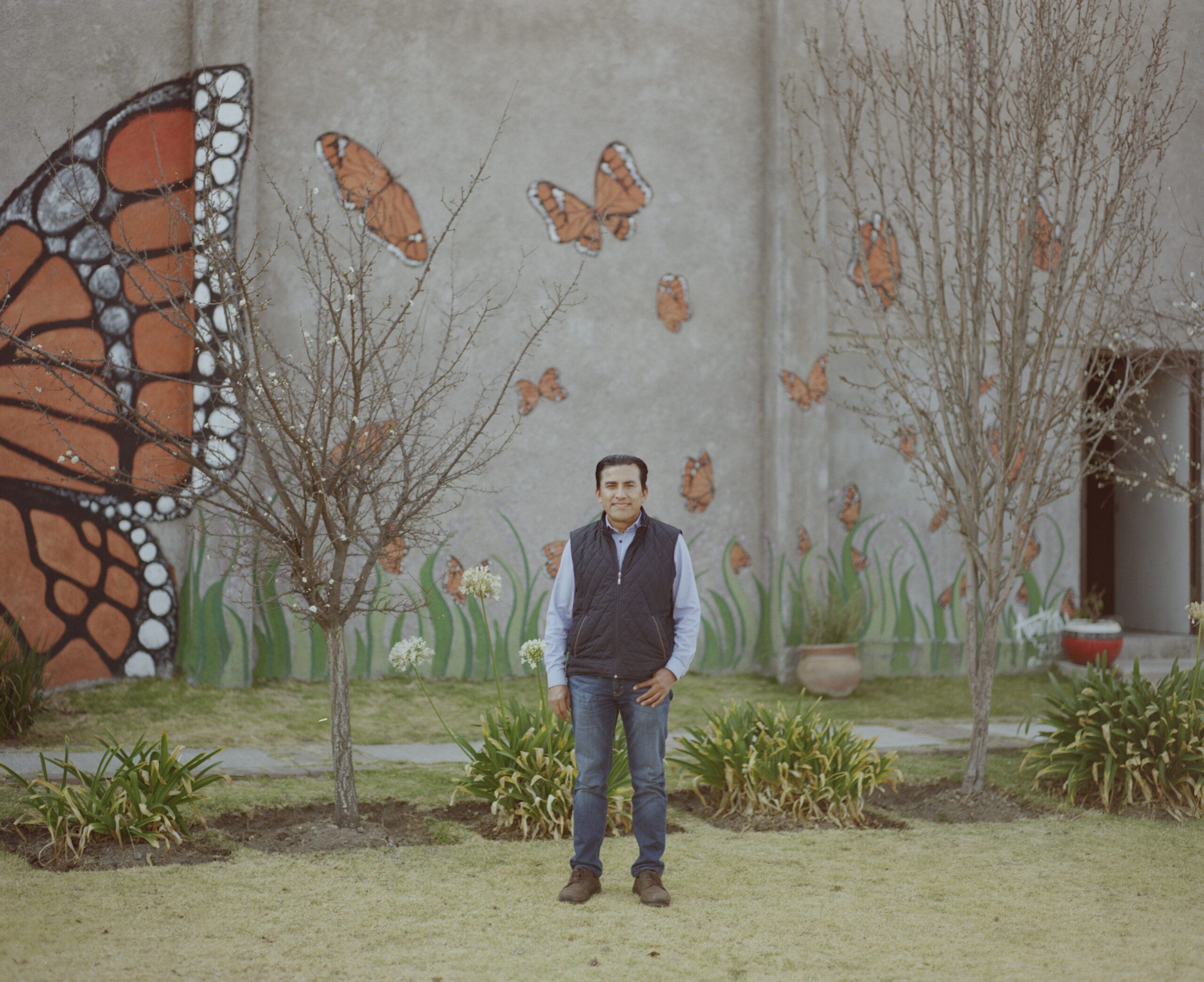“One day a memory came to me. I was four or five years old and my parents had taken me to this region (around Valle de Bravo, Mexico) for the weekend. In the morning I was playing in a field with a local boy, with his little lambs and sheep when…a cloud obscured us and a lady said ‘it’s the monarch butterfly’. For half an hour they covered the skies. I was about five years old and I never remembered again, I forgot. Years passed and one day I was on a flight from Mexico City to Ixtapa with three friends, and from the heights we witnessed how the forest was burning below. It was in May, that really struck me, and a week later I went to Valle de Bravo, where another fire was burning where there is now the Piedra Herrada Sanctuary. That was when I recalled my experience from when I was little, and I thought to myself someone has to do something. That was 20 years ago.”
Oscar Contreras is colloquially known as el Dueño de las Mariposas (the owner of the butterflies). He has dedicated his life to understanding the Monarch Butterfly’s behaviours and implementing strategies with local communities in Mexico to conserve their habitats.

“On November 1st, during the Day of the Dead, all of the cemeteries of Michoacán and the State of Mexico are covered with butterflies. They are so precise, like clockwork they arrive exactly on November 1st. And then on March 21st, during the spring equinox they fly away. According to indigenous communities, the Monarchs represent the arrival of the souls.”
The Monarch Butterfly is known worldwide to have one of the longest insect migration routes in the world. Every year the population traverses three countries: Canada, USA and Mexico. Some have even been recorded in Argentina.
“About 1,000,000,000 Monarchs leave Canada, yet only one in ten makes it to México. So how do you invert the statistics, how do you make sure that nine out of ten arrive?”
Over the past 20 years the Monarch’s population has severely declined and scientists are viewing it as a sign of how we are dangerously altering our landscapes.
“Mexico used to be a beautiful garden. Not only Mexico, the whole of North America was a garden when the colonisers arrived. With every species of plant, flowers and vast forested areas. That’s how it used to look like. And the Monarchs came and went at their leisure. Today, they face golf courses, highways, cities and agricultural areas, of course their numbers are in decline…
“Now why should we care if the Monarch disappears? Well, if the butterfly dies, what a pity. She was very pretty… No, no, no, the Monarch Butterfly has a role. A role in nature, among others. Pollination like bees, they both have their gestation roles, they impact the seasons and the nature they encompass. The design is perfect. So if this balance is broken, it has other consequences. If there are no butterflies we should see it as a warning light flashing…
“In the 90s, between the states of Mexico and Michoacan, the Monarch butterflies could be found in 20 hectares, today that number has dwindled to 0.67 hectares. In only 14 years…What caused the decline? Clandestine logging, deforestation, soil degradation and fires.”
In the last 20 years, Mr Contreras has implemented socio-economic strategies throughout Mexico, working with the local ejidos (indigenous land owners), empowering them to manage butterfly sanctuaries through eco-tourism.

“The monarch is what keeps the local economy going, it gives life and butterflies to the entire region… We believe that it is a socio-environmental issue. In Mexican culture you need to include the social aspect, if not there can’t be talk of conservation. It is difficult if there are no alternatives that help the owners of the land become nature’s allies. We want them to take care of the forest and the butterflies. So we see it from their perspective. If the problem is felling, cutting, burning, soil degradation, it is usually due to lack of economic opportunities. These communities take care of all of México, they have ancestral knowledge and love.”
Their pilot project, Piedra Herrada, is a sanctuary two hours west of Mexico City, near Valle de Bravo. When you enter the sanctuary you pay 100 pesos per person and are assigned a local guide that will walk you up the path towards the area where the butterflies are found. Depending on the time of year, they are at different heights of the mountain. We arrived in February, and the butterflies were near the peak. Once we arrived, the fluttering noise became palpable, as though you were encountering a single moving entity. The guides make sure that tourists are respecting the rules: silence, not disturbing the butterflies, and only staying 15 minutes in the area they inhabit. About 200 people are employed by the sanctuary and its income is managed by the local ejido where an elected board redistributes the income according to the number of families within the community.
After the Mexican Revolution in 1917, Mexico reformed its land rights, redistributing corporate land and giving it back to indigenous villages, local communities and farmers. The land has since been managed by communal holdings with government oversight. The community decides through voting how to use the land and whether or not it can be sold. This system is known as ejidos.
“We arrived 20 years ago and it was a beautiful forest, well, not so beautiful because a lot of it had been logged. So we asked the farmers who owned it, and they directed us to the local ejidatarios, and we shared with them our vision: what if we create an economic system here but with environmental goals? Piedra Herrada was our pilot project… We did the project planning, the research, the training, we talked to the people, and eight years later we left them alone to be administrators of their own land.”
After the success of the pilot project, Oscar began a reforestation campaign to open other community-managed sanctuaries in the State of Mexico. He says that by that time reforestation had become a trend.
“During our first decade we simply reforested, then it became fashionable and everyone wanted to help us. New foundations appeared and together we reforested the Monarch’s Mexican route. Right now we still have a proposal to plant 15 million trees across 10 states.”
The Monarch is a living being and when she travels she not only needs rest but also food. After the sanctuaries proved a success, Mr Contreras realised that targeted gardens, or jardines, were required for the monarch to survive her odyssey.

“We came up with a plan to plant gardens for the butterflies, vegetable gardens that could also provide for the families from the communities. We saw it as an alternative income, the families could eat from the gardens and then sell their excess produce. So we planted 75 gardens with 75 families. They harvest their vegetables, beautiful lettuces, broccolis, everything, and the butterflies fill the gardens. The project then reached the ears of those from Green Latin America and out of 3000 other initiatives, we won first place. Winning that prize gave us the confidence to realise that we were on the right track. So we committed to completely reforesting the Monarch’s route with gardens and trees by 2030 and joining forces with the USA and Canada in an initiative called Ruta Monarca 2030.”
The Monarch conservation in the USA has been different to Mexico’s, as it hasn’t involved local communities. Although two NGOs, Monarch Watch and the Rewilding Alliance, have planted one million gardens along the highways for the butterflies to rest on. Oscar ponders on the different strategy in the USA, where one hundred years of National Parks, focused on a strategy that separates nature from people, has influenced the way local NGOs implement conservation strategies. The natural parks and reserves ultimately remove humans from their natural landscapes, disconnecting us from the creation and maintenance of pristine natural environments. This contrasts with Oscar’s interweaving of social, economic and environmental issues through a collaborative model between the local communities and their surrounding ecosystem, demonstrating that humanity is not always the problem but can be part of the solution.
This belief is reflected in a project Oscar is working on with the Monterrey Technological University, creating an app where the public can contribute to the monitoring and tracing of the Monarch Butterflies, as well as the health of the vegetable gardens that are now supporting them. The intention of the app is to educate people on the importance of the Monarchs’ ecosystem.
“We want to completely change the narrative. We shouldn’t think of how WE can help the butterflies, but rather what they are doing for us. Ultimately, it’s not them that need help, it’s us humans. So the app will have a strong educational aspect, as well as gathering data to share with all of the NGOs working towards the Monarch’s preservation.”
Oscar’s approach towards conservation centres indigenous custodianship of land, the importance of which is well-documented for the maintenance and regeneration of biodiversity. It also empowers people to become a force for good, highlighting that humanity is a key part of ecosystem recovery and that economic prosperity can support environmental regeneration.
Isabella Cavalletti is a storyteller and co-founded eco-nnect.













